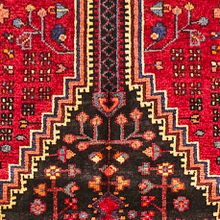Touserkan Rug
| Touserkan Rug | |
|---|---|
 Design of Touserkan Rug (Rugman) | |
| General information | |
| Name | Touserkan Rug |
| Original name | قالی تویسرکان |
| Alternative name(s) | Touserkan Carpet |
| Origin | |
| Category | Village |
| Technical information | |
| Common designs | Medallion, Geometric |
| Common colors | Navy Blue, Blue, Ivory, Beige |
| Dyeing method | Natural, Synthetic |
| Pile material | Wool |
| Foundation material | Cotton |
| Knot type | Symmetrical (Turkish) |
Touserkan rugs are produced by Kurdish nomads living in northwestern Iran. Time seems to have stood still for these people. They have not been influenced by modern conveniences and technology, preferring instead to live simple lives in the traditions of their ancestors. The women of the tribe weave area rugs on crude handmade looms that are compact and easy to transport when the time comes to move on. Many of the area rugs are woven for their personal use as sleeping mats and floor coverings in addition to being their main source of income. The women who weave these magnificent area rugs are most diligent and meticulous. It is not uncommon for a single rug to take months of concentrated effort. Touserkan rugs are created using the single weft Hamadan weave, also known as Sennah Baft, indicative of the region.
History
Touserkan, also spelled Tuisarkhan, is a town located in the Hamadan Province of western Iran. Touserkan rugs are known in the old rug market from the early twentieth century. The rugs have a cotton foundation and a medium to long wool pile. The Turkish (symmetric) knot is employed.
Touserkan rugs have geometric or semigeometric tribal designs in a medallion and allover style. There are a multitude of designs, including palmettes with leaves and vines and flower heads with a variety of animals, birds, and human figures. Additionally, these designs may have tribal, primitive ornamental motifs in the field and borders. A medallion characteristic in Touserkan rugs is a dominant pendant or hexagonal shape design. Touserkan rugs are categorized as Hamadan Mosul rugs. Mosuls successfully competed with the inexpensive Caucasian and Anatolian rugs of that era in the international marketplace.
Touserkan rug backgrounds are primarily dark blue, with a minority being shades of red or ivory. In addition to these colors, different shades of blue, brown, camel, gold, gray, and green are used for the main border, guard borders, and design elements. Dark blue or dark brown is woven for the design outlines.
The formats range from small mats to rugs approximately seven feet by four feet six inches, along with some runners made in a variety of lengths. Touserkan weavings are generally good to fine in grade quality.
Early Touserkan rugs measuring approximately four feet by seven feet can have a market value up to S5,000. By the last quarter of the twentieth century, some Touserkan weavers switched from weaving traditional designs to make rugs and carpets similar to those of neighboring areas in accordance with the demand of domestic and foreign export consumers.[1]
See also
| Search for Touserkan Rug on Wikipedia. |
References
- ↑ Moheban, 2015, 578
Bibliography
- Abraham Levi Moheban. 2015. The Encyclopedia of Antique Carpets: Twenty-Five Centuries of Weaving. NewYork: Princeton Architectural Press.